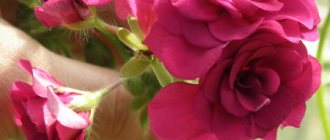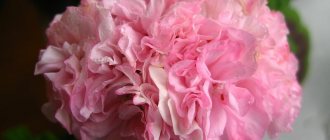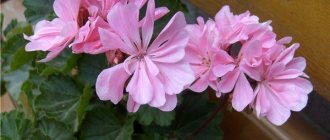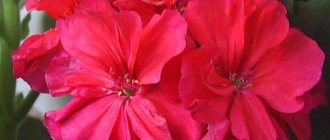Skip to content
Instagram VK
Tel. 8-996-686-71-22 (VIBER, WhatsApp). Email: [email protected]
Cvetovod86 cuttings and flower seedlings
Search
Cart / 0 ₽ 0
Cvetovod86 cuttings and flower seedlings
Instagram VK
Cart / 0 ₽ 0
350 ₽
Pelargonium 'PAC Apricot'-rooted cuttings
SKU: 4023 Category: Pelargonium Tags: Pelargonium 'PAC Apricot', Pelargonium 'PAC Apricot' cuttings
- Description
- Reviews (0)
Ivy-leaved pelargoniums are plants with an ampelous growth form, the dense leaves resemble the shape of an ivy leaf. Designed for planting in hanging flower pots or tall flowerpots. The length of the shoots can reach up to 1 meter. They respond well to formation. Pinching should be carried out at the initial stage of growth to form a beautiful bush. Feeding during the season. Requires a period of dormancy in winter, for abundant flowering in summer.
Pelargonium 'PAC Apricot'
Features of pelargoniums PAC
The name itself - pelargonium - sounds wonderful. However, to grow this wonderful flower, you need to take into account as many subtleties as possible. This fully applies to PAC pelargoniums.
Peculiarities
From the very beginning, it is worth mentioning that pelargonium forms a separate genus in the Geraniaceae family, and is not directly included in it. The popular opinion among gardeners that these are complete synonyms is completely wrong. As for the letters PAC, they indicate the trademark of the Elsner nursery located in Dresden. The first word in the abbreviation is pelargonium, the second is anthurium, and the third is chrysanthemum.
In all three cases, Latin names are used.
Varieties
Among the varieties presented below, each gardener will be able to choose a flower to his liking or create an ensemble of several beauties in his flowerbed.
- Pelargonium Foxy forms large caps. The foliage is painted in dark green tones, flowering occurs without any problems. The culture can hardly be called whimsical.
- Ivy-leaved pelargonium Vicky produces bright pink flowers. Judging by the descriptions, the closer the row of petals is to the center of the flower, the shorter it is.
- Blue Wonder is simply a gorgeous flower crop. The flower belongs to the zonal varieties. Semi-double flowers are painted in a non-standard lilac-bluish tone. In the very middle of the flower there is a white spot. The dark green leaves look very elegant.
- Lauretta, which produces semi-double flowers, has cyclamen-colored caps. The stocky bush branches heavily. Pink pelargonium with a white center looks very attractive.
- Lilac Rose is another ivy-leaved type. The plant produces dense double flowers of a delicate lilac color; Moreover, the bushes are relatively small.
- First Yellow is a rather rare variety, because yellow pelargoniums like it are not very familiar to gardeners. The variety was introduced back in the late 2000s, so experience with it has already been accumulated.
- Mexica Nealit creates pink-lilac flowers, from the middle of which a white ornament appears to emerge.
- The Victor variety fully lives up to its name. The flower of this pelargonium is very large and is characterized by a velvety red tone. The diameter is 0.05 m.
- As for pelargonium Angeleyes Orange , this variety has good resistance to frost. The flowers of the plant are small, which is compensated by their abundance. The culture is suitable for both home and outdoor conditions.
- The variety Emilia is a typical zonal pelargonium. The caps of this plant are quite large. Semi-double flowers are pink in color.
- Pelargonium Ameta is also popular. It's hard not to admire this purple flower with lavender eyes. The plant itself is medium in size, but the buds and flowers are invariably large.
- Red Sybil is painted differently - pure scarlet. When pelargonium of this variety is half-bloomed, it can easily be confused with a rose. All this, combined with the white lining, creates a truly stunning look. Plus, gardeners won’t have to put in any effort to get the crop to bloom.
- Happy Birthday stands out even among other PAC pelargoniums . The lacy, velvety leaves look absolutely stunning. The plant has graceful pink flowers. They are lighter on the outside and brighter inside.
- Blue Touch is one of the common zonal pelargoniums. Many flowers are formed on the peduncle. The inflorescences are large in size.
- But Flower Fairy Velvet is causing mixed reviews. The plant forms relatively small bushes. The caps are moderately large, but the pelargonium is very free-flowing. However, in flower beds where there is no one to trim the flowers, this is even a plus - the wind itself removes unnecessary petals.
- Wilhelm Langguth - this is the name given to variegated pelargonium. Dark green leaves have a white outer border. In bright sunlight, a darker area is revealed. Then the appearance becomes even more original and attractive.
- You should take Fairy Berry if you need pelargonium similar to fuchsia . There is a red spot in the middle of the petals. The compactness of the bush does not interfere with abundant flowering.
- The variety Evka is one of the variegated pelargoniums. The flowers are relatively small and bright red.
- It is appropriate to complete the review with the Fireworks Bicolor variety . The plant has pink petals, while the center is distinguished by an expressive dark burgundy spot. The variety is suitable for container growing, but it can also be used to decorate an ordinary balcony.
Growing
Varieties of PAC pelargoniums look different, but at the same time require mandatory care. Plants can survive direct sunlight, so unlike many other ornamental crops, they can be safely placed against the glass of a south-facing window. You can also plant pelargonium on both the northern and eastern sides, but sometimes you will have to take care of the lighting. If lighting is not provided, plants may stretch out in winter.
During the summer months, it is advisable to place pelargoniums outside. Important: the plant is not knocked out of the pots, but directly buried along with the containers.
In September or October (based on weather forecasts), pelargonium should be returned to the house. In the winter months, the plant should be kept at a temperature of no lower than 8 and no higher than 12 degrees Celsius.
The buds of future flowers will be formed only at temperatures from 11 to 13 degrees. This regime must be maintained for 75-90 days. Pelargonium should not be watered too diligently; between waterings, pause from 48 to 72 hours to allow the substrate on top to dry out. Even less water needs to be spent in the cold season in order to:
- retard growth;
- prevent foliage from wilting;
- prevent rotting of roots and root collars.
To learn how to trim and replant pelargonium at home, watch the video below.











